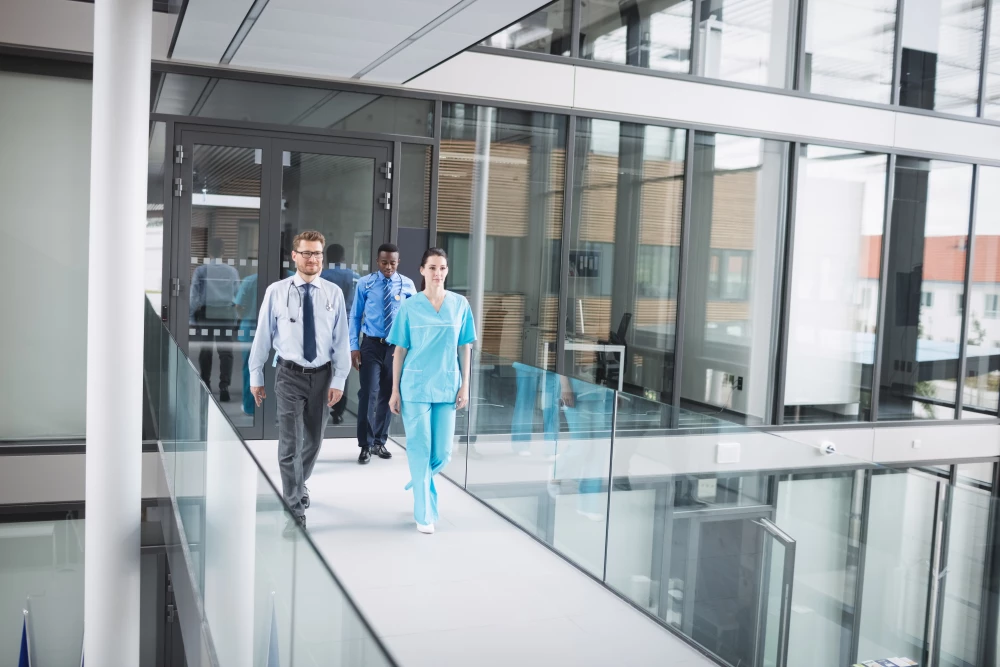
Lifts for Healthcare and Hospitals
Request a free site survey for healthcare and hospital lift installation today.At Lift Services, we specialise in lifts for healthcare and hospitals that prioritise safety, hygiene, and reliability.
Our systems are designed to meet the demanding requirements of healthcare environments, ensuring patients, staff, and vital equipment are moved smoothly and safely between floors.
From high-capacity bed lifts to smaller passenger lifts and dedicated service lifts, our hospital lift solutions are engineered to support 24/7 operation, adhere to strict hygiene protocols, and comply with all UK healthcare building regulations.
Request a free site survey for healthcare and hospital lift installation today.
How Much Do Lifts for Healthcare and Hospitals Cost?
The cost of healthcare and hospital lists is from £35,000 to £120,000.
The cost varies depending on size, load capacity, travel height, and features.
As a guide:
Standard passenger lifts for healthcare start from around £35,000 to £60,000.
Bed lifts with high capacity range from £60,000 to £100,000.
Specialised equipment lifts or large-capacity service lifts can exceed £120,000.
Every project includes a site survey and tailored quotation, with installation, safety certification, and staff training provided as standard.
What Are The Benefits of Lifts for Healthcare and Hospitals?
The primary benefit of hospital lifts is the safe, reliable, and efficient transport of patients and equipment.
Key benefits include:
Accommodates beds, stretchers, and medical equipment with ease
Enhances accessibility for patients, visitors, and staff
Supports 24/7 operation in critical healthcare settings
Meets hygiene standards with easy-clean materials
Improves patient comfort with smooth, quiet travel
Where Are Hospital Lifts Installed?
Hospital lifts are strategically installed throughout a healthcare facility to support the safe and efficient movement of patients, staff, equipment, and visitors.
They are installed in wards, emergency departments, operating theatres, diagnostic units, and service areas to support the movement of patients, staff, and goods.
Placement is determined by operational flow, clinical priorities, and building layout.
What Types of Lifts Are Best for Hospitals?
Bed lifts for patient transport, passenger lifts for visitors and staff, and service lifts for medical supplies are the most common.
Each type is tailored to its specific function.
The best types of lifts for hospitals are those specifically designed for clinical use, offering high reliability, hygiene-friendly features, and enough space for beds, wheelchairs, and medical equipment.
The choice depends on the hospital’s layout, patient needs, and traffic volumes.
he ideal choice balances size, safety, hygiene, and operational efficiency, while ensuring full compliance with healthcare standards.
Can Lifts Be Installed in Existing Hospitals?
Retrofitting lifts into operational hospitals is a common requirement, particularly in older NHS estates or private facilities undergoing modernisation.
While more complex than lift installation in new builds, it is both feasible and regulated under UK construction and healthcare standards.
A typical retrofitted hospital lift takes 4 to 10 weeks, depending on site conditions and whether new shafts or significant structural changes are required.
How Long Does a Lift Installation for Healthcare Hospitals Take?
The installation of a stage or hospital lift typically takes between 2 to 8 weeks, depending on the type of lift, site conditions, and whether structural modifications are required.
Planning for adequate site preparation and regulatory testing is essential to avoid delays.
What Safety Features Are Included?
Healthcare and hospital lifts include a robust set of safety features specifically designed to ensure the secure and reliable movement of patients, medical staff, and equipment.
These lifts are built to comply with stringent UK safety and healthcare regulations, prioritising hygiene, accessibility, and fail-safe operation.
Healthcare and hospital lifts are equipped with an extensive range of safety features, including emergency power, anti-bacterial finishes, overload detection, and precision levelling, to ensure patient safety, infection control, and compliance with NHS and UK regulatory standards.
How Often Should Hospital Lifts Be Serviced?
Due to high usage, we recommend servicing at a maximum of monthly or bi-monthly intervals, including comprehensive safety checks, thorough mechanical inspections, and cleaning of critical components.
Hospital lifts should be serviced at least every six months, in line with UK legal requirements.
However, quarterly servicing (every three months) is strongly recommended for most hospital environments due to the high frequency of use and the critical nature of lift access in patient care.
This requirement falls under the Lifting Operations and Lifting Equipment Regulations 1998 (LOLER), which legally mandates that any lift used to carry people must be inspected by a competent person at six-month intervals.
Can Lifts Be Made Hygienic for Infection Control?
While stage theatre lifts are not used in clinical environments, their surfaces and control systems can be adapted to meet enhanced hygiene requirements, particularly in venues concerned with public health, such as multi-use cultural centres, theatres in hospitals, or during periods of heightened infection risk (e.g. during a pandemic).
We use stainless steel or antimicrobial panel finishes, sealed control buttons, and ventilation systems that support hospital hygiene requirements.
In UK venues, efforts to improve lift hygiene should align with Health and Safety Executive (HSE) guidelines and, where applicable, NHS Infection Prevention and Control standards.
While not mandatory for all entertainment settings, these measures are often adopted as part of a venue’s health and safety risk assessments.
Request a Free Site Survey
If your facility requires hospital lifts that meet the highest safety, hygiene, and performance standards, Lift Services can deliver a fully compliant and reliable solution.
Contact us today to arrange a complimentary site survey and receive a detailed quotation.
